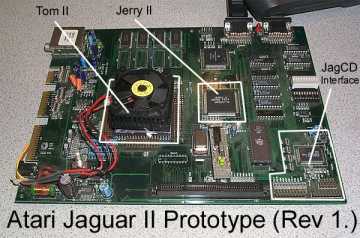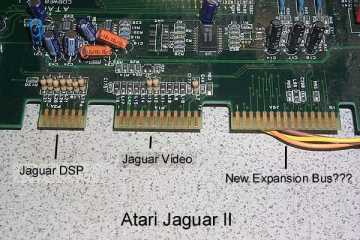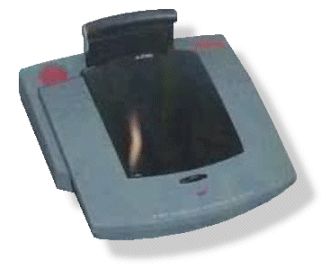home
site news
atari news
atari glossary
atari history
atari video game systems
> atari 2600
> atari 5200
> atari 7800
> atari lynx
> atari jaguar 64
> technical specs
> really 64bits?
> pcb-layout
> cartridge tech
> hardware
> software
> collection
> gallery
> 'panther'
project
> jaguar 2
> cojag
> kiddie rides
> 'do the math'
> atari jaguar CD
> atari xegs
atari computers
atari coin-op
atari stand-alone-systems
atari library
atari theater
atari links
legal stuff/imprint
contact us |
|
The 'Jaguar II' prototype

This
is the 'Jaguar II' prototype PCB. You'll notice, there is a second
DRAM-bank on the board; but it's empty...

These are the
expansion-ports of the 'Jaguar II'. What is / was the new expansion-bus
for?
Those are (were) the
possible 'Jaguar II' system-specs. They were stated in a german
online-magazine in 1995. The editors claimed, that they received these
specs from Atari-internal sources they were not able to reveal.
So
let's consider these as speculative, but not unrealistic:
|
Size: |
10.5" x 12" x 3.5" |
|
Controls: |
Power on/off |
|
Display: |
Resolution up to
1600 x 600 pixels (50 Hz/interlace)
32-bit 'Extended True Color' display with 16,777,216 colors
simultaneously (additional 8 bits of supplimental graphics data
support possible)
Multiple-resolution, multiple-color depth objects (monochrome, 2-bit,
4-bit, 8-bit, 16-bit, 24-bit) can be used simultaneously |
|
Ports: |
Cartridge slot/expansion
port (64 bits)
RF video output
Video edge connector (video/audio output) (supports NTSC and PAL;
provides S-Video, Composite, RGB outputs, accessible by optional
add-on connector)
Four controller ports
Digital Signal Processor port (includes high-speed synchronous serial
input/output) |
|
Controllers: |
Eight-directional
joypad, size 5" x 4.5" x 1.5", cord 7 feet, six fire buttons (A, B, C,
D, E, F), pause and Option buttons, 12-key keypad (accepts
game-specific overlays) |
| |
|
| |
|
|
'Tom' (including
processors 1-5), 1,250,000 transistors, 292 pins |
|
Graphics Processing
Unit (processor #1) |
64-bit RISC
architecture (64 / 128 register processor)
64 registers of 128 bits wide (shadow-buffering)
Has access to all 2 x 64 bits of the system bus
Can read 128 bits of data in one instruction
Rated at 127.902 MIPS (million instructions per second)
Runs at 63.951 MHz
2 x 32K bytes of zero wait-state internal SRAM (matrix)
Performs a wide range of high-speed graphic effects
Programmable |
|
Object processor (processor
#2) |
64-bit RISC
architecture
Programmable processor that can act as a variety of different video
architectures, such as a sprite engine, a pixel-mapped display, a
character-mapped system, and others. |
|
Blitter (processor
#3) |
64 bits read and
write at the same time! (multibuffering)
8K read buffer (fifo)
8K write buffer (lifo)
Performs high-speed logical operations
Hardware support for Z-buffering and Gouraud shading |
|
Texture Mapping
Engine (processor #4) |
64-bit RISC
256K 'texture-work-ram' of zero wait-state internal CACHE
capable of doing about 900000 texture-mapped polyons,
without textures there can do 2500000 polyons.
realtime Gouraud and Phong shading |
|
J/MPEG 'COMBI' Chip
(processor #5) |
64 bits
not programmable
8K own data rom (with sinus) table
128K CACHE (fifo)
realtime J/MPEG decompression via CACHE (fifo)
DRAM memory controller
4 x 64 bits
Accesses the DRAM directly |
| |
|
| |
|
|
'Jerry',
900,000 transistors, 196 pins |
|
|
Digital Signal
Processor (processor #6) |
32 bits (32-bit
registers)
Rated at 53,3 MIPS (million instructions per second)
Runs at 53.3 MHz
Same RISC core as the Graphics Processing Unit
Not limited to sound generation
96K bytes of zero wait-state internal SRAM
CD-quality sound (16-bit stereo 50KHz)
Number of sound channels limited by software (minimum 16)
Two DACs (stereo) convert digital data to analog sound signals
Full stereo capabilities
Wavetable synthesis, FM synthesis, FM Sample synthesis, and AM
synthesis
A clock control block, incorporating timers, and a UART |
|
Motorola 68EC020 (processor
#7) |
Runs at 26.590MHz
perfect 68000 emulation
General purpose control processor |
Communication is performed with a high speed 64-bit data bus, rated at
2400 megabits / second. The 68000 is only able to access 16 bits of this
bus at a time.
The
'Jaguar II' contains eight megabytes (64 megabits) of fast page-mode DRAM, in
eight chips with 1024 K each.
The
'Jaguar II' would have had seven processors, which are contained in three
chips. Two of the chips are proprietary designs, nicknamed 'Tom' and
'Jerry'. The third chip is a standard Motorola 68EC020, used as a
coprocessor. 'Tom' and 'Jerry' are built using an 0.3 micron silicon
process. With proper programming, all seven processors can run in
parallel.


These two pictures were
taken at the 1995 Summer CES in Chicago: Sam Tramiel carrying a 'JagDuo'
(a combination of the Jaguar and the CD add-on), or possibly the 'Jaguar
II'.

This
may have been the case for the 'Jaguar II' or probably the 'JagDuo' (a
combination of the Jaguar and the CD add-on).
|






